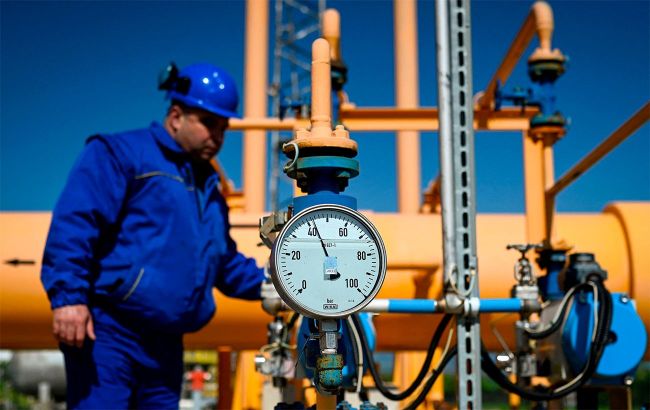Why Europe can't break free from Russia's gas dependence: Key questions answered
 Photo: Despite sanctions, Europe still buys Russian gas (Getty Images)
Photo: Despite sanctions, Europe still buys Russian gas (Getty Images)
Since the beginning of Russia's full-scale war against Ukraine, many importers of Russian energy resources in Europe have sought alternative sources. However, Moscow remains one of the top suppliers, making the European Union's goal of phasing out Russian energy by 2027 difficult to achieve.
RBC-Ukraine cites Bloomberg's article on why Europe cannot get rid of the “Russian energy habit”.
Content
- How Europe got hooked on the Russian gas
- How Europe uses Russian energy
- Why gas contracts with Russia remain in effect
- What other Russian energy resources get to Europe
- The current situation regarding Russian gas
- How Europe copes with high prices
Just three years ago, Russia was the world's largest exporter of natural gas, with Europe as its main customer. For the leading economies of the continent, access to cheap Russian energy outweighed any concerns or risks associated with doing business with Vladimir Putin.
In February 2022, Russia launched a full-scale invasion of Ukraine, and the heavy reliance on a single supplier suddenly became a threat to the region's economic and political security.
Fears that Putin would cut off gas, coal, and oil supplies as punishment for supporting Ukraine prompted a frantic search for alternative energy sources. This shift was officially formalized through sanctions aimed at halting funding for the Russian war machine.
As of today, some European countries have undergone a revolution in energy supplies. Gas, oil, and coal importers have turned away from Moscow in favor of alternative suppliers. Additionally, consumers have found ways to use less energy, reducing demand. Ultimately, lights remain on, and most factories continue to operate — despite Europeans paying more. Nevertheless, Russia remains one of the most important energy suppliers to Europe.
How Europe got hooked on the Russian gas
The story began more than half a century ago. The Soviet Union, amid tensions in relations with China and the US, needed money and equipment to develop recently discovered giant gas fields in Siberia.
West Germany was on the hunt for cheap energy to support its rapidly growing manufacturing sector. In 1970, they signed a "pipes for gas" deal. Under this agreement, German factories supplied thousands of kilometers of pipelines to transport gas to Europe. Supplies consistently increased until Germany found itself purchasing more than half of its gas from Russia.
In recent years, Germany and other European economies have begun transitioning to wind and solar energy. However, pipeline Russian gas has remained a convenient and inexpensive alternative for generating baseload power needed when the wind doesn't blow and the sun doesn't shine.
How Europe uses Russian energy
According to the Bruegel think tank (Brussels, Belgium), by the end of 2023, imports of Russian fossil fuels into the European Union amounted to around $1 billion per month, which is several times lower than the peak figures of early 2022, which reached $16 billion per month.
Most of this import still consists of natural gas. Russia accounted for approximately 15% of total gas supplies to the EU in 2023. According to the European Commission, it leads North African countries at 14% and ranks among the top three suppliers. Norway leads at 30%, followed by the US at 19%.
Most Russian gas arrives via pipelines through Ukraine and Türkiye. Major buyers include Austria, Slovakia, and Hungary, whose economies heavily rely on this fuel.
Liquefied natural gas from Russia is still purchased by large consumers such as Spain, France, Belgium, and the Netherlands. Some of this gas is mixed with other gas in the European pipeline network. This means, for instance, that Russian gas can potentially end up in Germany, which declared a complete phase-out of it a year ago.
Why gas contracts with Russia remain in effect
European clients of Russia are often constrained by rigid long-term contracts that cannot simply be canceled.
Furthermore, transitioning to other suppliers may be prohibitively expensive. Expected available supplies in the global gas market over the coming years are still likely to be limited until a new wave of supplies arrives from exporters such as the US and Qatar. The portion of gas available for import to Europe is absorbed by countries that have closed coal and nuclear power plants.
Austria, Slovakia, and Hungary are also seeking alternative suppliers. However, these countries do not have access to the sea, and their industries are tied to energy resource supplies from Russia, which are cheaper than gas arriving at LNG (Liquefied natural gas) terminals in Western Europe.
At present, there is no Europe-wide ban on importing Russian gas, although the UK, Germany, Poland, and the Baltic states have decided to cease purchases.
Some major European corporations have long-standing investments in Russian energy. For example, French company TotalEnergies SE remains a shareholder in the Arctic Yamal LNG project. The Spanish company Naturgy Energy Group SA has a 20-year contract to purchase liquefied fuel from Yamal until 2038.
What other Russian energy resources get to Europe
As of now, Russian crude oil supplies continue through pipelines, although at much lower volumes than before. There is still no ban on importing oil products produced at refineries outside the EU, such as those in Türkiye.
According to Global Witness, sales from these refineries to EU countries generated around $1.2 billion in tax revenues for Russia in 2023.
Additionally, some Russian crude oil is likely to reach Europe after being purchased by intermediaries in other countries and mixed with oil from other sources.
Since Russia deployed a large shadow fleet of tankers to circumvent international sanctions, tracking oil and liquefied gas has become more challenging. Parts of the shadow fleet have come under sanctions from the UK, the EU, and their allies, and there is no evidence of direct supplies to Europe. However, resale across the globe is difficult to trace.
For more information, read “Putin's shadow fleet: How Russia making money from oil trade and how the West reacts”.
The current situation regarding Russian gas
Last year, Russia accounted for less than 10% of gas consumption in Europe, which is more than a third lower than in 2022.
Norway has displaced Russia as the largest supplier of pipeline gas to the continent. The US has become the largest supplier of liquefied gas due to newly built LNG unloading facilities.
European countries have also reduced their energy consumption. This is partly because some industries that incur high electricity bills have scaled back their operations. However, it is also due to energy-saving measures (from January to August, gas demand was 20% lower than the average before 2022) and a record shift to renewable sources.
The energy crisis related to the Russian-Ukrainian war in 2022 forced Europe to accelerate its transition to green energy. According to research company Ember, electricity generation from gas and coal dropped to a record low. Last year, wind power in the EU generated more electricity than gas for the first time.
How Europe copes with high prices
In 2022, energy prices skyrocketed several times over. Some factories in European countries were forced to cut production, and many small businesses closed. Currently, prices have fallen but remain above pre-crisis levels, making energy-intensive sectors less competitive.
Households affected by soaring electricity bills have found ways to reduce consumption. For many, the additional costs present real hardships. According to the European Commission, nearly 11% of EU citizens could not keep their homes adequately warm in 2023.

